Now that we have brought awareness to our torso, this month we are going to look at leg stability. The torso has a big influence on the legs and how we control them, that is why it was addressed first…
Guérinière recommends lunging novice riders without stirrups so that they focus more on the seat and torso for balance and control rather than the legs and stirrups that are too short, causing a situation where “….the rider would be pushed from the saddle in trying to use the support of the stirrup.”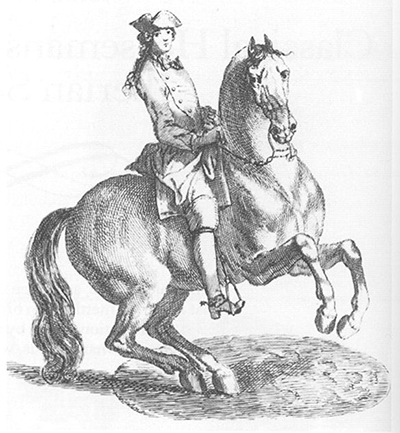
“….the rider would be pushed from the saddle in trying to use the support of the stirrup.”
The legs alternatively should be stretching down to help anchor the pelvis and there are other muscles as well that need our attention. The rider’s legs create energy in the horse and also help to direct that energy, so it is important that we have the legs fully under control, however, we must avoid against gripping with them to get our balance. They should rest against the horse’s side like wet towels, breathing with the horse and ready to give a stronger aid if need be. The reason for this softness is explained by Steinbrecht, “As the blind person touches the object before him very softly and lightly with his fingertips in order not to interfere with the work of his sensitive nerve ends by too much pressure, so it is the rider’s first obligation to keep soft and natural those parts of his body with which he feels his horse.” As a result, Steinbrecht wants us to keep our lower legs gently in contact with the horse so they can, “…act like steady barriers within which the hindquarters must work.”
Good control of the leg creates clearer communication with the horse. You need to be able to apply the appropriate leg pressure whenever you want. The thigh should be snug against the saddle but not restrictive, with the knees and toes pointing forward. Too strong a leg and the rider’s hips, knees and ankles become locked leading to possible tightness or even injury with the shock absorbing ability of the joints reduced. The hips will lose the ability to relax and open, inhibiting both horse and rider. Also, the horse can become tense and his breathing restricted. In this position, there is no leeway to give a clear aid, as the legs are already pressed hard against the horse’s side. Udo Burger explains, “…leg contact can vary form firm to light, but must never become a grip, pressure or squeeze of sufficient intensity to destroy all sensation of communication with the horse’s nervous system.”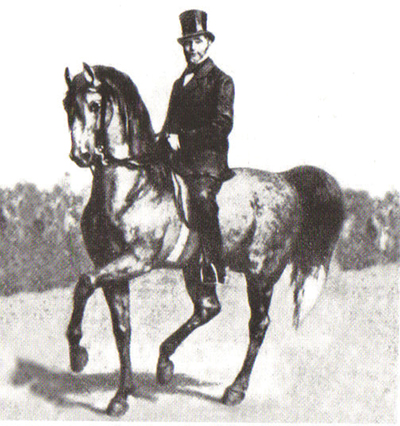
“It is the rider’s first obligation to keep soft and natural those parts of his body with which he feels his horse.”
Too loose a leg and the rider will give constant, involuntary leg aids will cause the horse to become dead to the leg and eventually ignore it altogether. The leg will also lose effectiveness as it becomes sloppy, the heel is lifted up and no positive tension remains. In this state, there will be no inside leg for the horse to bend around on a circle and no outside leg to guard against swinging hindquarters.
Riders often use leg muscles to control the legs which can result in what de La Guérinière warned against, “…the bad habit of holding their seat with their heels and calves,” which will lead to “embarrassment!” Also, often riders use too much gluteus maximus (especially the lower fibres) and external hip rotator muscles leading to legs that would be better suited to a frog than a horse rider. This, as well as overuse of the muscles on the inside of the thigh, the adductors, also pushes the seatbones out of the saddle. Relaxing the buttocks and getting better control from the gluteus minimus and the anterior fibres of the gluteus medius, helps to lower the centre of gravity and allows the seatbones to sink into the saddle aiding a deep seat while keeping the leg in a slightly internally rotated position while still allowing the lower leg to give aids in accordance to Podhajsky’s requirements, “The thigh should turn inwards from the hip and lie smoothly and firmly on the saddle without being clamped to it, which would lead to tenseness. The flatter the thigh, the firmer will be the rider’s seat. The flat thighs will make the seat open, which gives him a wider base. The thighs must be at an angle to the hips to enable the knees to lie forward on the flap of the saddle.”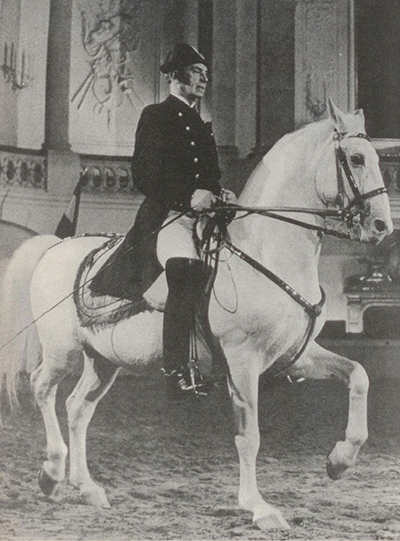
“The thigh should turn inwards from the hip and lie smoothly and firmly on the saddle without being clamped to it, which would lead to tenseness. The flatter the thigh, the firmer will be the rider’s seat.”
Guérinière also understood that control of the whole leg was initiated in the hip joint and therefore the thigh, “Properly speaking, it is not the legs which are turned when riding but rather the upper thigh; and when the thighs, and consequently the legs, are turned in one direction or another as much as they ought to be, so will be the feet.”
To see how well your glute medius and minimus muscles are helping you ride, while sitting in the saddle, maintain a slight bend in the knee and a relaxed ankle before taking your legs away from the horse at the hip, rotating them in and extending them back before replacing by the horse’s side. If this movement is accompanied by exclamations of, “Ouch!”, with “new awareness” in the side of your butt, you know there is work to be done!
Steinbrecht understood how difficult correct leg usage was to achieve and believed it to be, “…the privilege of such riders who have acquired a secure, balanced seat and do not need their legs to maintain it.” Understand that the hip joints have a big movement pattern, therefore the muscles I talk about are not the only ones used in riding, but they have an important role and are often underutilised. It helps to be aware of these muscles so that you can obtain a riding position using the correct muscles. These exercises will help you “switch on” the required muscles to help control the legs without disrupting the balance and stability of the torso, achieved by previous core exercises.
Now let’s put the theory into practice:
HOT POTATO
This exercise will help you disassociate the legs from the body. It helps to improve the stability of the body while the legs are moving so that your body remains still and keeps you from unbalancing the horse while you give legs aids.
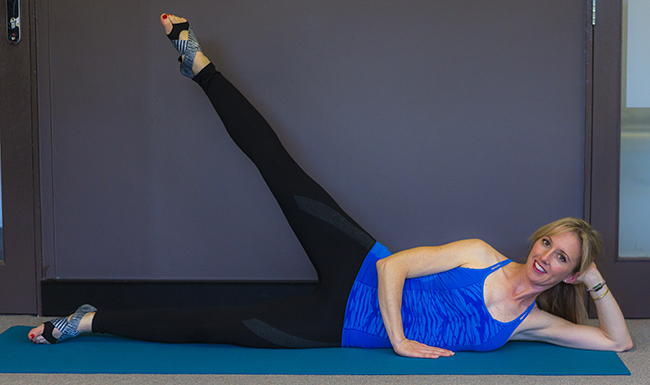
– Lie on you side, legs long and aligned with your hip and shoulder, resting your head on your lower hand with a bent elbow. If you feel unstable, you can bend your lower leg slightly. Make sure there is a little space under your lower waste to ensure your hips and knees remain stacked while keeping your ribs connected to the ground.
– Add lateral breathing (breathing in through the nose and out through the mouth)
– Switch off global muscles: arms and leg
– Switch on core
INSTRUCTION OF MOVE
On an in breath, kick the top leg up to the ceiling and place it down in front of the lower leg and tap five times while exhaling.
Breathe in to kick the leg back up and then tap down five times behind the lower leg on an out breath.
Repeat and tap four times in front and behind then three times, twice and once, maintaining good stability of the body. Only kick the leg up as high as you can maintain this stability. As you already know, the correct technique must trump range of movement.
Repeat on the other side.
DIAGONAL LINE “CLAMS”
This exercise will help you find the gluteus minimus muscle and the anterior fibres of your glute medius at the side of the bottom which will help you lift your legs off the horse and internally rotate them. It will also improve your ability to give light, precise leg aids as you will gain better control of your leg. When the exercise is executed slowly and with purpose, the muscles will gain the ability to control and support the hip joint, no matter what leg aids you are giving.
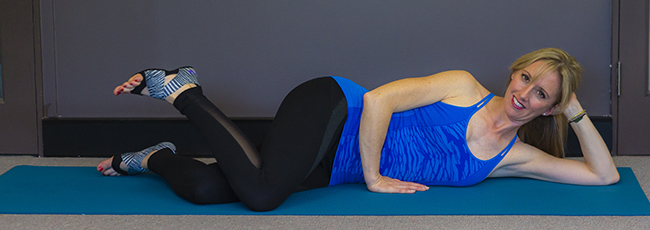
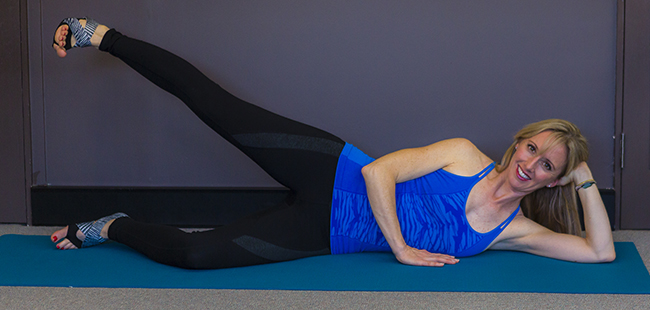
The set-up is the same as “Hot Potato” except now the knees are bent at a 45 degree angle. Make sure your knees remain stacked. It is very easy to let the top knee roll behind the lower knee. It is very important to avoid this misalignment.
INSTRUCTION OF MOVE
– Breathe in and touch the top knee to the ground, just in front of the lower knee with the top lower leg aligned on a diagonal line heading slightly behind your body. The whole top leg should be slightly internally rotated from the hip and the top foot should be flexed.
– Breathe out and slowly straighten the top leg. You should maintain resistance in the movement, as if you’re pushing away something heavy with your top foot. Keep your hips stacked and the internal rotation on the leg. You will find at the top of the move, your leg has reached a “dressage position”.
– Breathe in at the top of the move then breathe out to resist slowly back to the start position.
– Aim for ten repetitions then switch to the other side.
SEATED PIGEON STRETCH
If you find your toes stick out when you ride, you might be overly tight in your lateral rotator muscles. This exercise will help stretch them out and therefore make it easier to find your internal rotators in the exercise above.
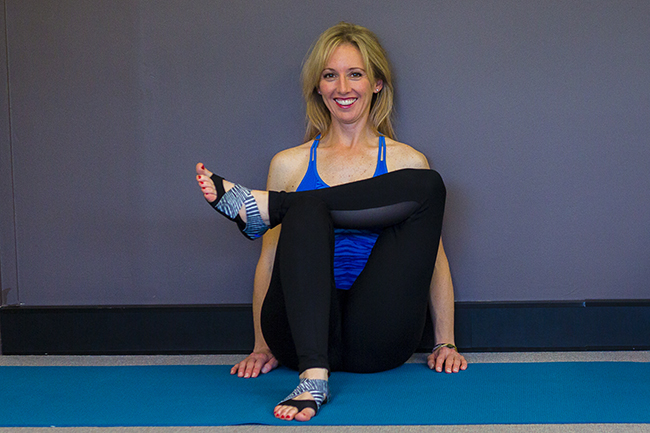
INSTRUCTION OF MOVE
– Sit with your knees bent and hands supporting you behind, fingers facing towards you. If it is hard for you to maintain a neutral spine in this position, you may prefer to sit against a wall.
– Cross one leg over the other so that the lower leg is supported by the opposite knee. You should feel a stretch in the back of the butt of the leg that is crossed.
– Rock side to side until you find the tightest muscle fibres and hold the position there for a few breaths.
– Repeat other side
Rebecca Ashton is a Qualified Pilates Instructor (UK CYQ Level 3), and a BHS Trained and EA Accredited Dressage Coach (Level 1). View the rest of the articles in this series below!



